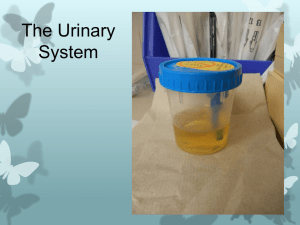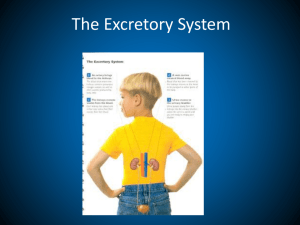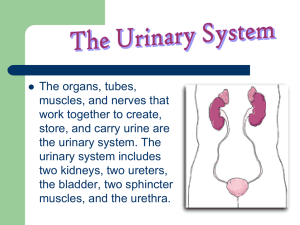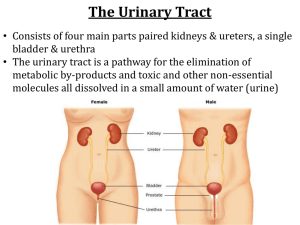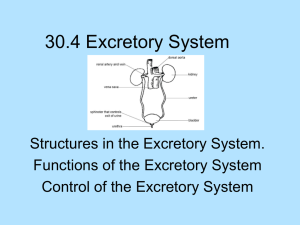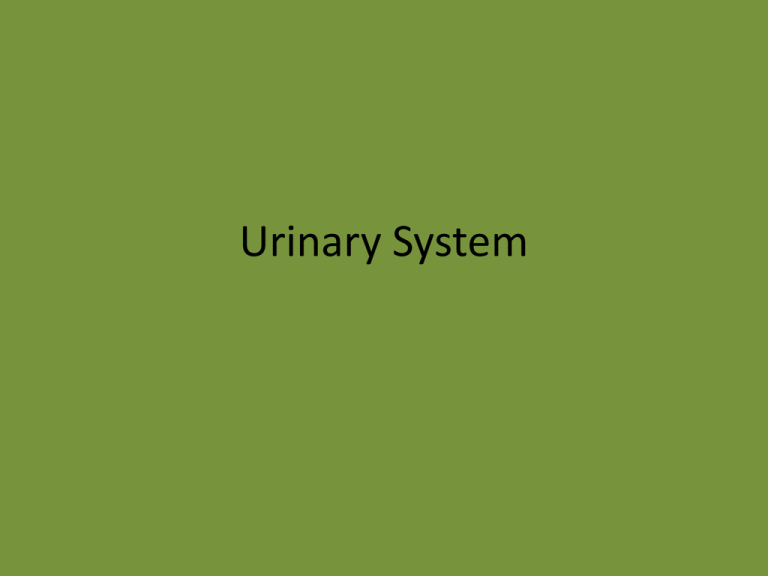
Urinary System
Other names for this system:
• Urinary tract
• GU-genitourinary system
• Excretory system
– genitourinary and urogenital: 2 systems in close
proximity and with shared structures
– tract: a continual pathway
– excretory: describes the purpose of the system (to
excrete urine)
KIDNEYS
• Reddish-brown in color,
shaped like a kidney
bean.
• Located under the
lower rib cage
KIDNEY
• Hilum-area of
indentation, medial side
• Renal artery- enters and
renal vein exits
• Adrenal glands-not part
of this system.
Kidney
• Renal cortex layersurrounds the kidney
• Renal medulla-underneath
renal cortex-triangular
shaped renal pyramids are
located
• Renal pyramids-connected
to minor calix-drains urine
which drain into- major
calix
Kidney
• Major calix- drains into the
renal pelvis
• Renal pelvis- drains into the
ureter
Ureter/Bladder
• Bladder- pelvic cavity, held
in place by ligaments
• Rounded top is called the
fundus
• Bladder is lined withmucosa-when empty it
folds into rugae.
• Bladder neck- sphincter
Male Urinary system
Ureter/Bladder
Urethra
• External Urethral Sphincter: muscular ring in
the urethra, it can be consciously controlled
• Penis: structure that is part of the male
reproductive system
• Prostate gland: glad that is part of the male
reproductive system
• Urethra: tube that carries urine from the
bladder to the outside of the body
• Urethral Meatus: the opening to the outside
of the body that is at the end of the urethra
Female Urinary Tract
Caroline, Priscilla, Alanna, Brittany
How it Flows
• Urine goes through the kidneys and is filtered
• Flows through the ureters which are about a
foot long to the bladder
• The bladder has a sphincter that holds urine in
• Urine finally travels through the urethra which
is one to two inches long.
• During pregnancy the
bladder is often
compressed by the
expanding uterus.
o Urinary System: includes the kidneys, ureters,
bladder, and urethra. It produces and excretes urine.
o Cortex: area of tissue beneath the capsule of the
kidney
o Flank: back area “between the ribs and hip bone”
that overlies the kidneys
o Medulla: area of tissue beneath the cortex of the
kidney
o Glomerulus: network of intertwining capillaries
within the glomerular capsule in the nephron.
Filtration takes place here
o Parenchyma: functional area of the kidney that is
made up of cortex and medulla and contains
nephrons
o Collecting duct: common passage way that collects
fluid from many nephrons. Reabsorption takes place
there
o Distal convoluted tubule: tubule of nephrons that
begins at a nephron loop and that ends at a
collecting duct. Reabsorption takes place here too
o Glomerular capsule: ball shaped structure that
surrounds the glomerulus and collects filtrate.
Nephron Loop
• Nephron function unit of kidney and
site of urine protection
• Glomerulus network of intertwining
capillaries
• Glomerulus capsule filtrates urine and
goes to the tubule
• Proximal convoluted tubule
reabsorption occurs (water and
nutritional substances return to blood)
• Nephron loop more water and
electrolytes are reabsorbed
• Distal convoluted Tubule more water,
electrolytes, amino acid are absorbed
• Collecting Duct urine is collected
Nephron
• Nephron: microscopic functional unit of the
kidney
• Nephron loop: U-shaped, reabsorption takes
place here
• Proximal Convoluted tubule: reabsorption
takes place here, begins at the glomerular
capsule and ends at the nephron loop
Ureter
• Peristalsis: process of smooth muscle
contractions that propel urine through the
ureter
• Ureter: tube that carries urine from the pelvis
of the kidney to the bladder
• Ureteral Orifice: opening at the end of the
ureter as it enters the bladder
Bladder
• Bladder: expandable reservoir for storing
urine
• Fundus: dome-shaped top of the bladder
• Mucosa: mucous membrane lining that is
inside the bladder
• Rugae: folds in the mucosa of the bladder that
disappear as the bladder fills with urine
• Sphincter: muscular ring around a tube
Vocabulary
o Urinary System: includes the kidneys, ureters,
bladder, and urethra. It produces and excretes urine.
o Cortex: area of tissue beneath the capsule of the
kidney
o Flank: back area “between the ribs and hip bone”
that overlies the kidneys
o Medulla: area of tissue beneath the cortex of the
kidney
o Glomerulus: network of intertwining capillaries
within the glomerular capsule in the nephron.
Filtration takes place here
o Parenchyma: functional area of the kidney that is
made up of cortex and medulla and contains
nephrons
o Collecting duct: common passage way that collects
fluid from many nephrons. Reabsorption takes place
there
o Distal convoluted tubule: tubule of nephrons that
begins at a nephron loop and that ends at a
collecting duct. Reabsorption takes place here too
o Glomerular capsule: ball shaped structure that
surrounds the glomerulus and collects filtrate.
o Urinary System: includes the kidneys, ureters,
bladder, and urethra. It produces and excretes urine.
o Cortex: area of tissue beneath the capsule of the
kidney
o Flank: back area “between the ribs and hip bone”
that overlies the kidneys
o Medulla: area of tissue beneath the cortex of the
kidney
o Glomerulus: network of intertwining capillaries
within the glomerular capsule in the nephron.
Filtration takes place here
o Parenchyma: functional area of the kidney that is
made up of cortex and medulla and contains
nephrons
o Collecting duct: common passage way that collects
fluid from many nephrons. Reabsorption takes place
there
o Distal convoluted tubule: tubule of nephrons that
begins at a nephron loop and that ends at a
collecting duct. Reabsorption takes place here too
o Glomerular capsule: ball shaped structure that
surrounds the glomerulus and collects filtrate.
- Creatinine: waste product from muscle contractions
- Electrolytes: substances that have a positive or negative
charge & conduct electricity when dissolved in a
solution
- Erythropoitin: hormone secreted when blood cells in
the blood decreases
- Filtration: process in which water, some nutritional
substances, and waste in the blood are pushed through
the pores
- Reabsorption: process by which water and nutritional
substances in the filtrate move out of the tubule and
return to blood in capillary
- Renin: enzyme secreted by the kidney when the blood
pressure decreases
- Urea: waste product from protein metabolismremoved from the blood by kidneys
- Uric acid: waste product from purine metabolismremoved from body by the kidneys
- Urination: the process of peeing- also known as
voiding, micturition, or passing water
- Urine: water, waste products, and other
substances excreted by the kidneys
Diseases and Conditions of the
Urine and Urination
By Katie B. and Kinga F.
• Albuminuria
– Presence of albumin in the
urine
– Also called proteniuria
(albumin is the major
protein in the blood)
– Occurs when there is
kidney disease and the
large protein molecules
pass through damaged
pores into the urine
•
Anuria
–
–
Absence of urine
production by the
kidneys
Caused by acute or
chronic renal failure
• Bacteriuria
– Presence of bacteria in the
urine
– Indicates a UTI
– Normally, urine is sterile
•
Dysuria
–
–
–
Difficult or painful
urination
Due to many factors
Ex: Kidney stone, cystitis
• Enuresis
– Involuntary release of urine
– Nocturnal enuresis is
involuntary urination at night.
• Frequency
– Urinating small amounts
often
– Can be caused by kidney
stones, enlargement of
prostate gland or and
infection
• Glycosuria
– Glucose in the urine
– Indication of an elevated
blood pressure
• Hematuria
– Blood in the urine
– Can be obvious or only
detected through laboratory
tests.
– Can be the caused by a kidney
stones, cystitis, bladder
cancer, and others
Diseases
• Renal failure- When the kidneys decrease their
urine production and stop producing urine.
• Uremia-excessive amounts of waste product
urea in the blood because of renal failure.
• Bladder cancer- Cancerous tumor on the lining
of the bladder
• Cystitis- inflammation or infection of the
bladder.
Diseases
• Urinary retention- The inability to empty the
bladder because of damage due to certain
drugs.
• Epispadias- Condition in which either both
sexes urethral meatus is an abnormal location
near the clitoris or the glands of a penis.
• Urethritis- Inflammation or infection of the
urethra.
• Hernia- Weakness in the muscle of the
diaphragm.
• Over active bladder- involuntary contractions
that cause urinary urgencies.
Lab Procedures
Summer, Meg, and Paige
Blood Urea Nitrogen (BUN)
•
•
•
•
Measures the amount of urea
Monitors kidney function/kidney disease
Watch for signs of nephrotoxicity
In patients taking aminoglycoside antibiotic
drugs
Culture and Sensitivity (C&S)
• Identifying the cause of urinary tract infection
by putting urine in a Petri dish
• The disease causing microorganisms are
tested
Leukocyte Esterase
• This detects esterase
• The test gives quick results so that treatment
can be started quicker
Urinalysis
• Detects substances in urine and describes
characteristics in it
• The simplest way is a dip stick test
• Different colors mean different characteristics.
Colors
• Light yellow to amber means normal urine
• Pink or smoky colored urine means bleeding
in the urinary tract
• Turbid (cloudy or milky) means white blood
cells and urinary tract infection
Odor
• Faint odor means normal
• People with diabetes have a fruity smelling
urine because of the glucose in it
pH
• Normal urine is slightly alkaline or basic
• Bacteria grows quickly and some types of
kidney stones form more readily in alkaline
Protein
• Not normally found in urine
• Presence indicated damage to the glomerulus
Glucose
• When found in urine, it can indicate
uncontrolled diabetes mellitus, from excess
glucose spilling into the urine from the blood
Red Blood Cells
• Microscopic examination to count red blood
cells
• Even clear urine can contain occult (hidden)
blood
Catheterization
• A catheter is a flexible tube, inserted through
the urethra and into the bladder to assist in
the draining in urine
Dialysis
• Removes waste products from the blood for a
patient with renal care
• Hemodialysis uses a shunt in the patients arm
• Peritoneal dialysis uses a permanent catheter
inserted through the abdominal wall
By: Danny, Mike, Aine, John, Maggie
Diseases continued
• Hesitancy: Inability to initiate a normal stream of
urine. Less volume.
• Hypokalemia: Decreased potassium in the blood.
• Incontinence: Inability to keep urine in the
bladder.
• Ketonuria: Ketone bodies in urine. Ketones are
waste products when fat is metabolized.
• Nocturia: Urination during the night.
• Oliguria: Decreased urine do to kidney failure.
Diseases Continued
•
•
•
•
Polyuria: Excessive production of urine.
Pyuria: White blood cells in urine (UTI).
Urgency: Strong urge to urinate.
Urinary Tract Infection: Any infection in the
urinary tract due to bacteria.

